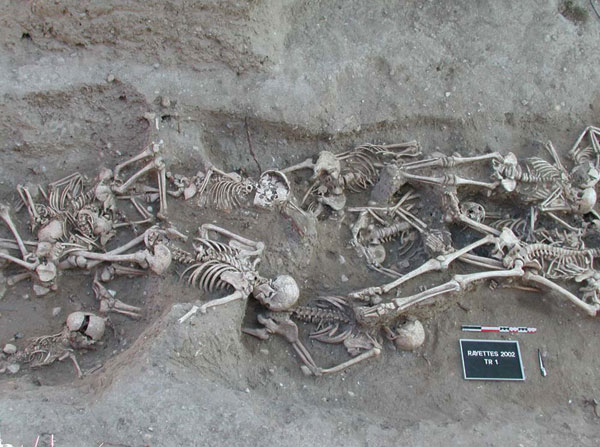During the 1300’s, strong thirsts for power between countries, religious divisions in Europe, and competition for trade routes were common. Trade routes connected the Eastern Hemisphere with the trade of various goods and information, and controlling these trade routes proved to be rewarding. Unfortunately, these trades routes “also likely carried the deadly plague that killed as many as half of all Europeans within seven years, in what is known as the Bubonic Plague.”1
Beginning in 1348, Bubonic Plague infested merchant ships sailing from the Black Sea to Mediterranean ports, causing so much death that it was common for ships to enter European docks and harbors with at least the majority of the crew dead. Despite efforts to prevent ships from reaching land and spreading the disease, the Bubonic Plague made its way ashore. Unfortunately, people found out how contagious the Bubonic Plague was as it swept through Sicily, Italy, and into the rest of Europe. As a result of the virtual inability of people to stop the spread, many suffered and died.

At the height of the Bubonic Plague, it had spread from China to London, devastating entire villages and bringing trade to a virtual standstill. It has been estimated that as many as 200 million people lost their lives as a result of the Bubonic Plague. In fact, it had a mortality rate that varied between regions.2 Although the Black Death was responsible for killing millions of people in Europe, it was a strong force in influencing the structure of power in the Eastern Hemisphere.
Marchione di Coppo Stephani, a chronicler who lived through the ravages of the plague in Florence during the summer of 1348 wrote,
At every church they dug deep pits down to the water level; and thus those who were poor who died during the night were bundled up quickly and thrown into the pit; they then took some earth and shoveled it down on top of them; and later others were placed on top of them and then another layer of earth, just as one makes lasagna with layers of pasta and cheese.3
It not only underlines the crisis for a major European city, generated by the death of tens of thousands of people, but also demonstrates how, even in recording such a profound crisis, a chronicler might evoke a homely, if provocative, image of lasagna.4 People believed that the world was coming to an end. Who was to blame? Other religions, or was it God punishing people for their sins?
As a result of much death and destruction on a scale that people have never seen before, people began wondering if God had been punishing them all along. There was no safe haven for people, even in isolated Russia, for the Black Plague did not hesitate to take any lives—every one was a target.
In the same year [1346], God’s punishment struck the people in the eastern lands, in the town Ornach [on the estuary of the River Don], and in Khastorokan, and in Sarai, and in Bezdezh [at an arm of the River Volga], and in other towns in those lands; the mortality was great among the Bessermens, and among the Tartars, and among the Armenians and the Abkhazians, and among the Jews, and among the European foreigners, and among the Circassians, and among all who lived there, so that they could not bury them [sic]. 5
In fact, religious hatred and persecution was very inhumane and common. With the strong belief that other groups were responsible for the Plague, the methods involved in persecuting other religious groups were cruel. Some common examples were: burning, stoning, decapitation, and exile.
The Black Death was devastating. It had killed millions of people across Europe and Asia. Anarchy, fear, and insecurities dominated the landscape in Europe during the 1300’s.[ 5. Sharon N. DeWitte, “Age Patterns of Mortality During the Black Death in London, A.D. 1349–1350,” Journal of Archaeological Science 37, no. 12 (December 1, 2010): 3394-3400, https://www.ncbi.nlm.nih.gov/pmc/articles/PMC3094018/ (accessed October 12, 2016).]
- Andrew Lawler, “How Europe Exported the Black Death,” Science 352, no. 6285 (April 29, 2016): 501–2. ↵
- Encyclopedia Britannica, February 2015, s.v. “Black Death.” ↵
- Marchione Di Coppo Stefani, “The Florentine Chronicle,” 1903-1913, accessed, October 18, 2016. http://www2.iath.virginia.edu/osheim/marchione.html. ↵
- John Henderson, “Debating Death and Disease,” History Today 64, no. 4 (April 2014): 58–59. ↵
- Celestine Bohlen, “Diphtheria Epidemic Sweeps Russia,” The New York Times, January 29, 1993, sec. World, http://www.nytimes.com/1993/01/29/world/diphtheria-epidemic-sweeps-russia.html. ↵



76 comments
Megan Barnett
Well written and I liked how you quoted your primary source document directly because it gave me as a reader a better feel for how the people during this time felt. It was rather shocking though to read that he compared the burial of the people to lasagna. However, this did represent a lot because it showed how desperate people were during the plague that they could not give their loved ones even a slight proper burial.
Josselyn Arrieta-Meraz
The Bubonic Plague is a sad reminder on how humanity can be wiped away so easily with the spread of such a dangerous disease. The fact that the burial of these victims was described as a lasagna says so much in so little. These amout of deads was astonishing and it just kept happening to a point where there were so many dead bodies, that in fact were still carrying the disease. If it wasn’t for the advancement of medicine many of us wouldn’t be here. Great informative article!
Evelin Joseph
The Bubonic Plague is a very depressing event that took many lives and learning more about it through this article was great. It is mind boggling that these diseases traveled through the world by trade routes and ships. It is extremely devastating that this plague took millions of lives, even more so to learn that there were so many deaths they did not even have enough space to store the bodies. It spread more than just death, as it led to fear and violence against other religious groups as well. Hopefully, nothing to this extent ever takes place again.
Veronica Spryszynski
The bubonic plague was a horrifying event in European history. I wonder how those sites of the mass graves of people are today. The plague took so many lives that they had to bury people where burials were abnormal. One question I know and would like to know is how the bubonic plague came to an end. I was taught that this disease was found in cats and rats, but they still didn’t know the primary source.
Amber Aragon Alvarado
The fact that lasagna was used to compare a mass grave is really going to taunt me the next few times I eat lasagna. I can’t imagine what it was like during the plague. The fact that many people blamed others for the death of individuals just made the situation a million times worse. It got to a point that people from Europe and Asia had no idea what to blame the plague on that the turned to killing each other. This event, being historic, demonstrates how badly lives were effected at that time. Thankfully, we haven’t seen such an epidemic since the Black Plague as it allowed society to invent medications needed for survival. Great article overall!
Karina Nanez
How awful and devastating it was to have lived through these dark times. The image and description of the pits where the sick and dead were buried is sickening, I’m not sure I’ll ever look at lasagna the same way ever again. And the sheer scope of this disease, not only being spread in Europe but making it’s was into Russia. This article was incredibly well written but also very frightening.
Edith De Loera
During my years of grade school, we were often taught of the Black Plague and its effect on the millions of people around the world. This article explained very well how this epidemic was the most disastrous events in Global History. In the medieval era, the time in which the disease claimed millions of lives, people had little to zero knowledge of viruses. I enjoyed this article particularly because of the information provided on how and where the Bubonic Plague traveled.
Nahim Rancharan
I enjoyed reading this article. It did an excellent job at highlighting the main point of the Black Plague and its effect on millions of people around the world. It was interesting to see how a simple disease could influence millions of lives and how sources such as a religion could take a toll on people facing a crisis as big as this one. The Black Death is, no doubt, one of the most catastrophic and unfortunate events in World History, claiming the lives of about one-third of the European population. At a time of its prime, with trade and increased power among nations, the plague provided a level playing field, affecting the lives of people coming from both high and low income backgrounds. Great Article!
Alyssa Vela
This was a great article! I remember reading/learning about this when I was in high school, but had you asked me about it a few hours ago my answer may have been vague, because it was so long ago. It’s always amazed me how something can have so much influence on the way people live their lives. The Black Plague is something the world had to face head on, and will always be disturbing to look back on in our history. This was an amazing read. I loved your analogies and look forward to reading more of your work in the near future!
Mario Sosa
It is a miracle that humans were able to recover from the black plague relatively quick. To see piles upon piles of human corpses thrown into pits had to have been extremely traumatizing. Having little to no understanding of bacteria and viruses in the medieval era, I can understand why people would pin the blame on God or other groups. Great work on the article, I especially liked reading about the plague from the chronicler’s point of view.